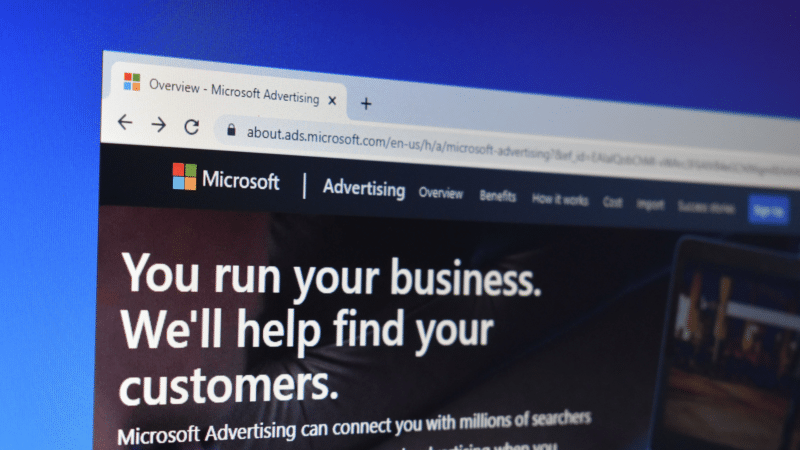
Microsoft Advertising remains the underappreciated gem in the digital advertising landscape.
While Google Ads dominates search globally, Microsoft’s ad platform has quietly built a significant presence. In desktop search, it commands over 30% of the U.S. market.
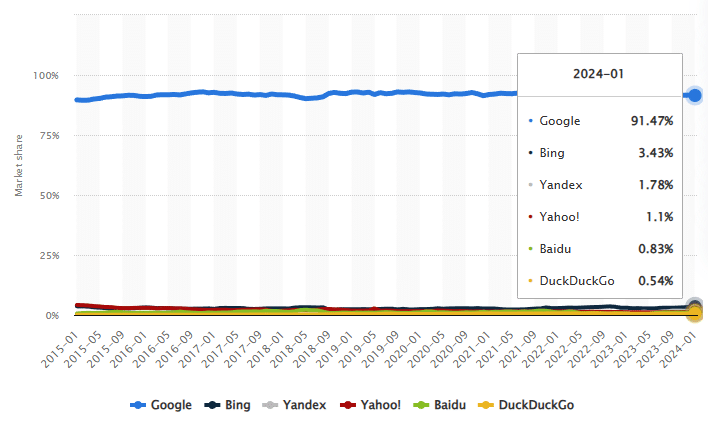
This reach shouldn’t be surprising, as Microsoft Ads extends beyond Bing to a network that includes Yahoo, AOL and numerous partner sites.
For advertisers fixated solely on Google, this represents a missed opportunity to reach millions of users, many with higher-than-average household incomes and active engagement in B2B research.
With digital advertising costs rising on Google’s platform, smart advertisers increasingly turn to Microsoft Ads as a vital component of their PPC strategy.
Whether you’re looking to expand your reach, reduce your cost per acquisition or tap into Microsoft’s unique targeting capabilities, understanding this platform is essential for any serious digital marketer.
What is Microsoft Advertising?
Microsoft Advertising (formerly known as Bing Ads) is one of the newer PPC platforms among search engines.
While Google launched Google Ads (originally AdWords) in 2000, Microsoft took a few more years to develop its own solution.
Initially, Yahoo served ads on MSN, but by 2006, Microsoft began investing more heavily in its own advertising technology.
In 2010, Microsoft took over Yahoo Search, selling ads across both Yahoo and Bing.
The platform was rebranded as Microsoft Advertising in 2019, a name that appears set to stay.
The special thing about Microsoft Ads, compared to Google, is that Microsoft integrates several previously independent platforms for advertising, while Google primarily relies on its search engine and YouTube.
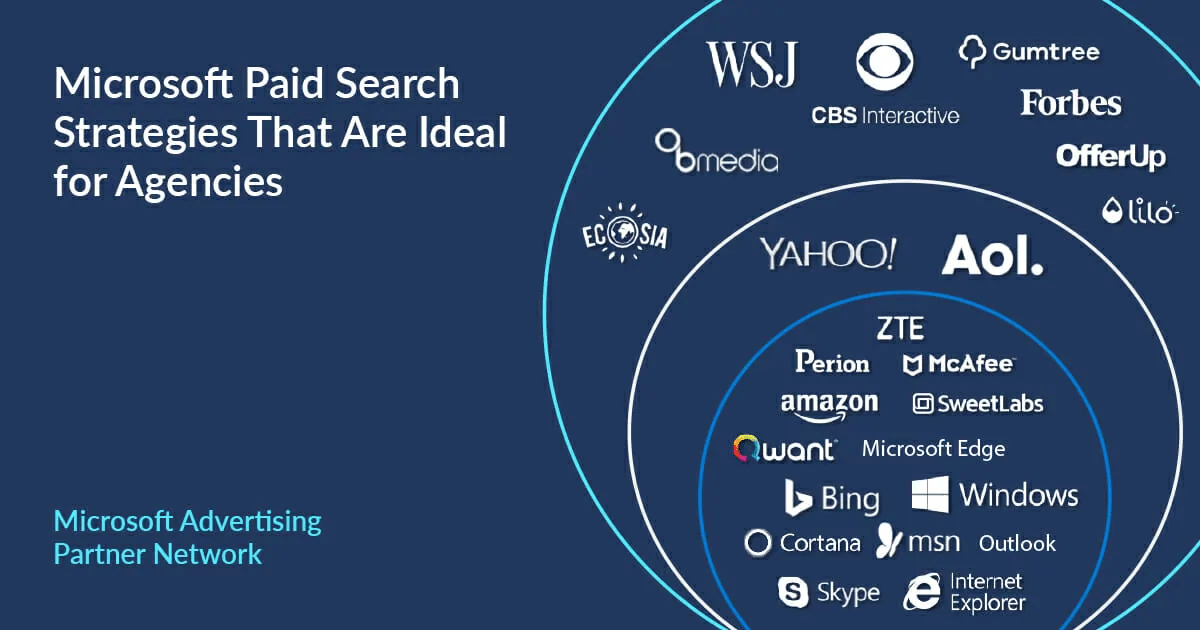
The Microsoft Advertising Partner Network consists of:
- Microsoft products: Bing, MSN, Edge and Outlook.
- Partnerships: Yahoo and Ecosia (a search engine focused on sustainable projects which uses Microsoft search results).
While it might seem overwhelming at first glance, it’s important to understand Microsoft Ads and its historical path to growing such a network.
Google’s dominance as a search engine is undisputed. Its search market share is 80-90% or more, depending on the country or market. This trend continues on mobile.
To compete and attract media buyers, building and growing a network over time is essential.
Focusing solely on Bing would not have worked for Microsoft, especially since products like YouTube are difficult to replace.
Rather than attempting to replicate Google directly, Microsoft chose to develop its own PPC platform by:
- Forming partnerships.
- Adding ad placements.
- Establishing search partnerships and collaborations over time.
Microsoft Ads vs. Google Ads
A common question is how Microsoft Ads compares to Google Ads.
While both platforms share many concepts and structures, there are key differences in the details.
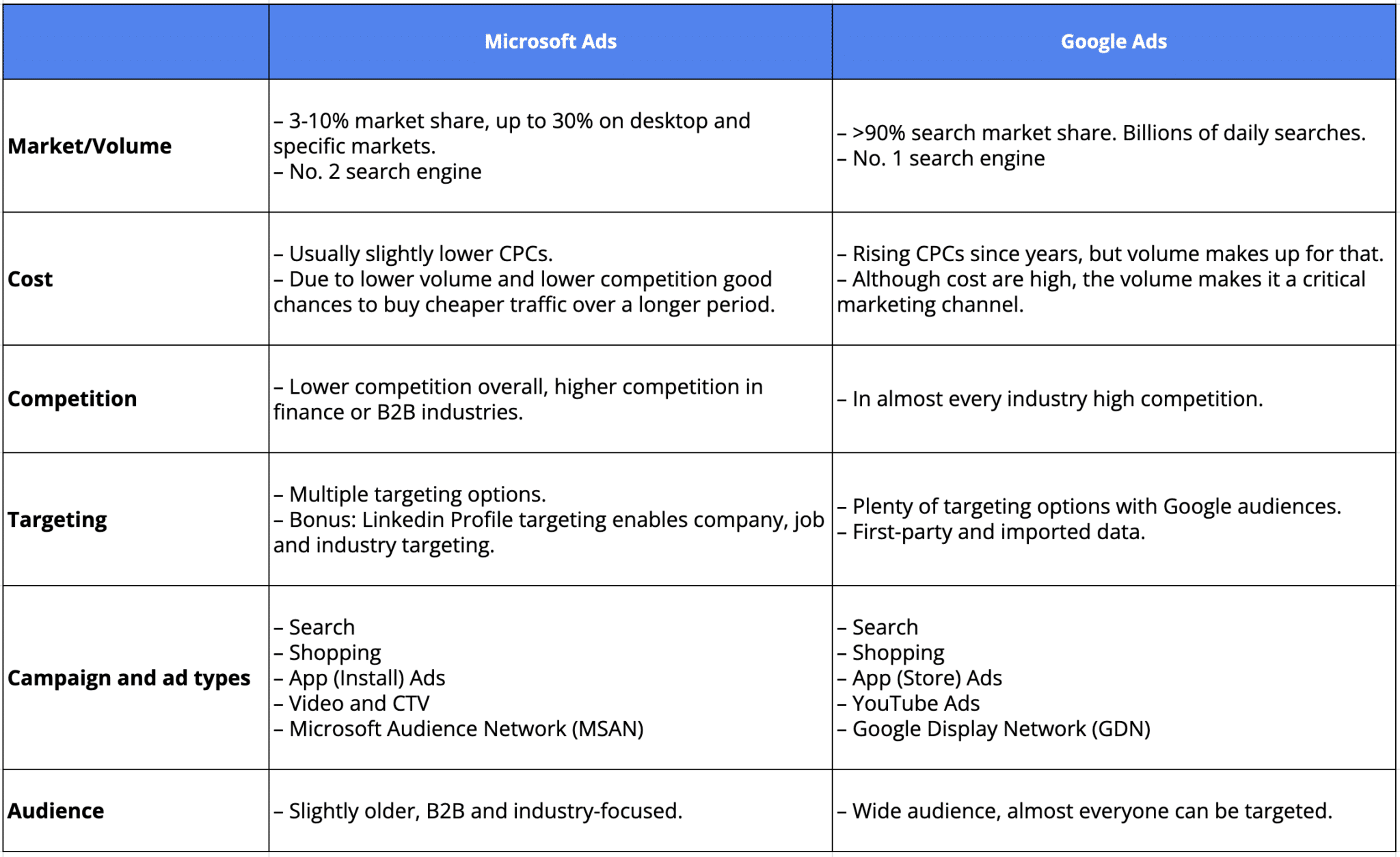
Microsoft Ads typically offers lower CPCs and less competition than Google Ads, making it a more budget-efficient option for advertisers.
It excels in B2B advertising, particularly with its LinkedIn targeting, which allows for precise targeting by company, job title and industry.
While its audience tends to be older and more business-focused, Microsoft Ads offers fewer campaign types than Google’s broader network, including YouTube and Display advertising.
Although Microsoft’s overall reach is smaller, it often provides better value, especially in markets where Google’s rising costs and competition make profitable campaigns more challenging.
This is why Microsoft Ads is an essential complement to Google Ads, particularly for advertisers in B2B and finance sectors.
Microsoft Ads campaign types and ad formats
Search campaigns
Search campaigns are the foundation of Microsoft Advertising.
They connect advertisers with users at the crucial moment when they are actively searching for relevant products or services.
While the basic concept is similar to Google Ads, success requires an understanding of Microsoft’s unique features and requirements.
Campaign structure and setup
A well-structured campaign begins with thoughtful organization.
- Instead of grouping everything into one campaign, divide efforts by product lines or business goals.
- Use focused ad groups with 10-20 closely related keywords to enable more relevant ad copy and improve quality scores.
- Clear naming conventions are essential for maintaining clarity as your account grows.
- Also, dynamic search ads can be used to automatically target specific pages or categories, offering an efficient way to discover new keyword opportunities.
Ad formats and extensions
Responsive search ads (RSAs) are now the standard format in Microsoft Ads.
With up to 15 headlines and four descriptions, they provide flexibility for Microsoft’s AI to test combinations and optimize performance.
While expanded text ads are being phased out, Microsoft compensates with a wide range of ad extensions.
Beyond the standard sitelinks, call and location extensions, it offers unique options like action extensions, which can give your ads a competitive edge.
Another standout format is multimedia ads which help brands stand out in search results with visually striking advertisements.
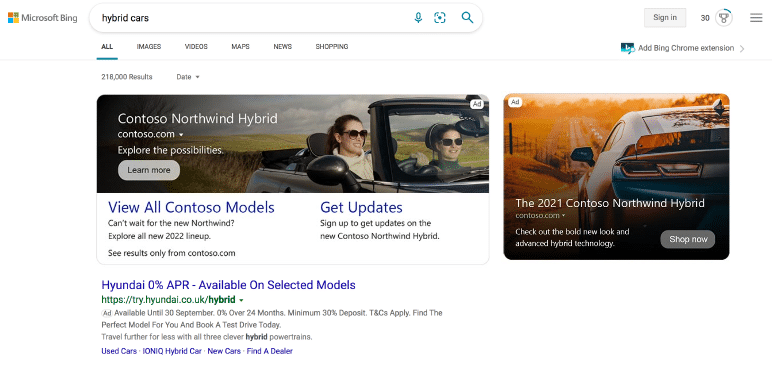
Unlike traditional text ads, these combine compelling imagery, brand logos, and optimized ad copy to create high-impact placements in premium positions – both in the mainline and sidebar of search results.
A key advantage of Multimedia Ads is their ability to maintain existing text ad positions while adding visually enhanced touchpoints to engage potential customers.
These ads automatically adapt their format to match user search intent, seamlessly combining headlines, descriptions, images and logos into layouts optimized for driving engagement and conversions.
Keyword strategy and management
Success in Microsoft Ads search campaigns depends on smart keyword selection and management.
- Instead of relying solely on broad match keywords, use a balanced approach.
- Start with exact match for proven performers and phrase match for controlled expansion.
- Broad match can be effective but requires careful negative keyword management.
- Regularly analyze search terms to find opportunities and exclude irrelevant terms.
Bidding and optimization
Microsoft Ads provides various bidding strategies to suit different goals.
- Manual CPC offers full control.
- Automated options like Enhanced CPC or Target CPA can deliver better results once you have sufficient conversion data.
Starting with slightly higher bids can help gather data quickly, allowing for performance-based optimization.
Monitor device performance closely, as desktop users on Microsoft’s network often behave differently than on Google, and adjust bid modifiers accordingly.
Also, note that smart bidding works differently on Microsoft due to lower traffic and conversion volumes, which can limit the algorithm’s effectiveness.
Don’t expect a smart bidding strategy to perform well if you lack the data for it. Keep your campaign setup simple to concentrate data and improve algorithm performance.
Shopping campaigns
Microsoft Shopping campaigns enable retailers to showcase products directly in search results with rich details like images, prices and merchant information.
Although often overshadowed by Google Shopping, Microsoft’s platform offers competitive CPCs and serves as a valuable additional revenue stream for ecommerce businesses.
A key advantage is that Microsoft integrates its Merchant Center within the advertising platform, eliminating the need to use a separate platform.
Advertisers can choose between standard Shopping or Performance Max campaigns to launch product ads, which appear on Bing’s search results page or shopping tab.
Product ads, alongside search ads, are core formats in Microsoft Ads and are essential for any ecommerce business seeking to maximize its reach and revenue.
Microsoft Audience Network
The Microsoft Audience Network (MSAN) complements traditional search advertising by enabling brands to reach audiences through premium native placements.
Unlike standard display advertising, MSAN delivers ads that integrate seamlessly into the user experience across platforms such as MSN, Outlook.com, Microsoft Edge and select publisher partners.
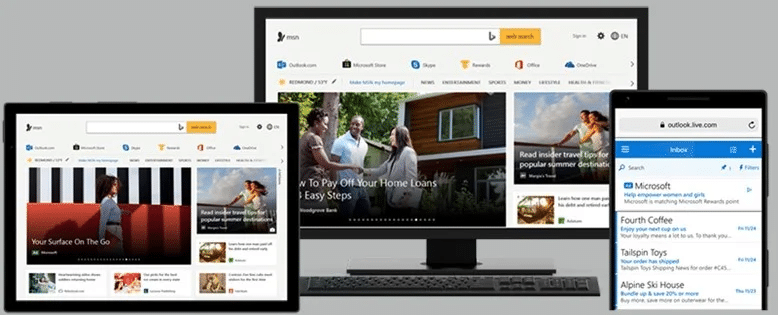
MSAN’s unique targeting capabilities, including LinkedIn integration, set it apart.
Advertisers can target audiences by company, industry or job function, offering precision unmatched on other platforms.
Ad formats include:
- Single-image ads for clean, native placements.
- Multi-image carousel ads for showcasing multiple products.
- Feed-based ads for dynamic catalog-based advertising.
- Video placements for rich media engagement.
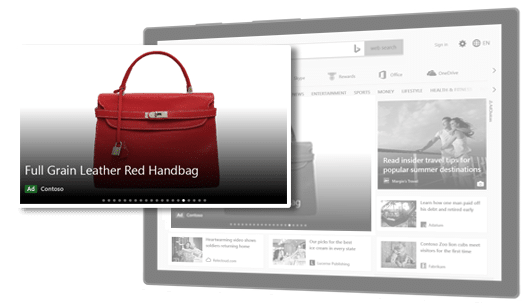
Successful MSAN campaigns require a strategic approach.
Start with brand search remarketing audiences, as these users are more likely to engage.
High-quality creatives – featuring clear headlines, compelling calls to action and high-resolution visuals – are critical for capturing attention.
Performance patterns differ from search campaigns, with lower cost-per-clicks and earlier touchpoints in the purchase journey. This makes MSAN ideal for brand awareness and top-of-funnel objectives.
Optimization is key for sustained success in MSAN.
- Regularly refresh creatives to prevent ad fatigue and refine audience targeting to focus on valuable prospects.
- Begin with manual bidding to gather data, transitioning to automated strategies as conversion history grows.
- Analyze device performance and time-of-day trends to allocate budgets effectively.
Dig deeper: 7 LinkedIn Ad settings and tactics you didn’t know you needed
Video and Connected TV ads
Microsoft’s newer ad formats focus on video and connected TV (CTV) advertising, providing diverse opportunities to engage audiences across premium publishers and platforms.
These video ads are served on high-traffic properties, including:
- MSN’s content network.
- Microsoft Casual Games.
- Activision Blizzard gaming platforms.
- Major publishing partners such as:
- Huffington Post.
- People.
- CBS Sports.
- Other premium content sites.
Microsoft offers two primary video ad formats:
- Instream: Ads that play before, during or after video content.
- Outstream: Ads that appear within article content or elsewhere on a webpage.
Microsoft’s entry into the streaming television space allows advertisers to reach cord-cutters and streaming audiences through full-screen video experiences on popular platforms like:
- Netflix.
- Roku.
- discovery+.
- Other major streaming services.
The key advantage of CTV ads is their TV-like experience. These ads typically achieve high completion rates as viewers engage in a lean-back, content-consumption mode.
Advertisers can achieve significant volume with these formats but should proceed cautiously, monitoring data closely, as they are relatively new with limited long-term case studies.
Upper-funnel formats like video tend to require substantial budgets, so starting with just $500 may not be effective.
Success depends on a well-thought-out media plan and strong creative assets.
Dig deeper: Microsoft Advertising shares 6 latest product updates
Vertical ads
Vertical ads are Microsoft’s tailored approach to industry-specific advertising, designed to display the most relevant information for specific sectors rather than using a one-size-fits-all format.
These ads are built to match how consumers search and shop within particular industries, showing the most critical information pre-click.
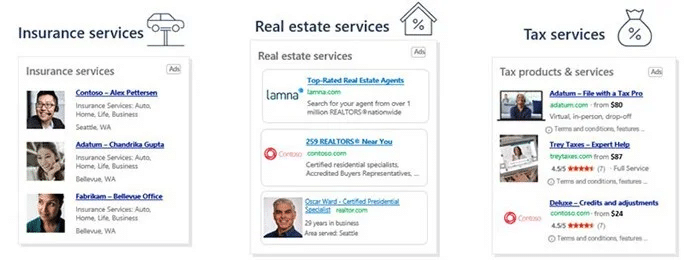
- In the travel sector, vertical ads display essential details such as cruise itineraries, hotel prices, and tour options directly in the ad.
- For financial services, they highlight features like credit card rewards and insurance coverage, simplifying complex decision-making for users.
- Automotive advertisers can showcase inventory with specifications, pricing and images, delivering a virtual showroom experience right within the search results.
Vertical ads are easy to implement. Despite their sophisticated functionality and appearance, they require minimal effort from advertisers.
Microsoft’s system leverages existing product feeds and data catalogs, with AI handling the creation and optimization of these industry-specific ads.
Tracking and tagging in Microsoft Ads
Proper tracking setup is essential for measuring success and optimizing your Microsoft Ads campaigns.
The platform provides multiple methods to track conversions and user behavior, catering to various needs and technical setups.
The universal event tracking (UET) tag is Microsoft’s primary tracking solution, comparable to Google’s global site tag.
This JavaScript snippet must be installed on all pages of your website and serves two key functions:
- Tracking conversions and goals.
- Building remarketing audiences.
Setting up the UET tag is a critical first step when starting with Microsoft Ads.
Without it, tracking conversions or creating remarketing lists is impossible.
It should be placed in the header of every webpage, preferably using Google Tag Manager for simplified management.
Microsoft Ads supports several conversion tracking options:
- UET tag-based conversions
- Track specific page visits (e.g., thank-you pages).
- Monitor user actions (e.g., button clicks, form submissions).
- Track custom events and variables.
- Measure transaction values.
- Offline conversion imports
- Upload offline sales data.
- Track phone call conversions.
- Import CRM data.
- Match offline conversions to specific ad clicks.
To accurately attribute performance, Microsoft uses the Microsoft Click ID (MSCLKID) as a URL parameter.
It is strongly recommended that you activate auto-tagging under account-level settings. This eliminates the need for manual tagging, reduces tracking errors and saves time.
Clarifying misconceptions about Microsoft Ads
‘It’s just a smaller version of Google Ads’
While Microsoft Ads shares similarities with Google Ads, it is not a scaled-down version.
Unique features like LinkedIn targeting, its audience network and distinct search partners set it apart.
Also, user behavior on Microsoft Ads often differs, which makes it worthwhile to develop Microsoft-specific strategies rather than simply duplicating Google Ads campaigns.
‘The traffic quality is lower’
This misconception is unfounded. Microsoft’s search network tends to attract users with higher household incomes and greater education levels on average.
Its strength in professional and B2B searches makes it especially valuable for business-focused advertisers.
‘The volume is too low to matter’
Although Microsoft’s overall market share is smaller than Google’s, it still reaches millions of users daily.
On desktop devices and in specific markets, Microsoft’s share can climb to 30%, offering access to a significant untapped audience that’s often more affordable to reach.
‘It’s only worth it for B2B companies’
While Microsoft Ads excels in B2B advertising, it is also effective across many other sectors.
Ecommerce, services and consumer products can perform well when advertisers understand their audience and leverage Microsoft’s unique targeting options.
‘It’s too complicated to manage another platform’
Modern PPC management tools simplify handling multiple platforms.
While importing campaigns from Google Ads is an option, treating Microsoft Ads as a distinct channel with tailored optimizations typically delivers better results.
The potential ROI often justifies the additional management effort.
‘It can replace Google Ads’
This is a risky assumption. Microsoft Ads should complement, not replace, Google Ads.
While Microsoft Ads offers excellent ROI and access to unique audiences, Google’s dominant market share remains irreplaceable for most businesses.
A strategic approach that leverages the strengths of both platforms is ideal.
Why you should avoid using the Google Ads import for Microsoft Ads
While the Google Ads import feature in Microsoft Ads appears convenient, it often results in suboptimal performance.
Based on my experience, relying on this tool is a primary reason many believe “Microsoft Ads do not work.”
Here’s why creating dedicated Microsoft Ads campaigns is a better approach:
Campaign structure should be more focused
Microsoft Ads operates with lower search volume compared to Google, requiring a more concentrated campaign structure:
- Combine similar low-volume ad groups.
- Focus on top-performing keywords rather than broadly targeting new terms.
- Group related products or services together rather than segmenting too granularly.
- Allocate budgets tightly to ensure meaningful data collection.
Importing Google’s expansive structure often leads to excessive low-volume ad groups and keywords that fail to gather sufficient data for optimization.
Leverage Microsoft-specific features
Simply importing campaigns misses out on Microsoft Ads’ unique features, including:
- LinkedIn targeting for precise B2B campaigns.
- Microsoft-exclusive audience segments for refined targeting.
- Unique platform-specific ad formats that improve user engagement.
- Industry-specific vertical ads tailored for key sectors like travel, automotive and finance.
Tailored optimization approaches are essential
Microsoft Ads requires adjustments to achieve optimal results:
- Use higher starting bids to gather data more quickly.
- Adopt aggressive bid management to compensate for lower volume.
- Pay attention to device performance patterns, as these often differ from Google.
- Use unique demographic and audience targeting options.
While the Google Ads import tool may initially save time, building campaigns specifically for Microsoft Ads allows you to fully take advantage of its features.
Ultimately, this delivers better long-term results and ensures the platform’s potential is fully realized.
source https://searchengineland.com/microsoft-advertising-guide-448914

0 Comments